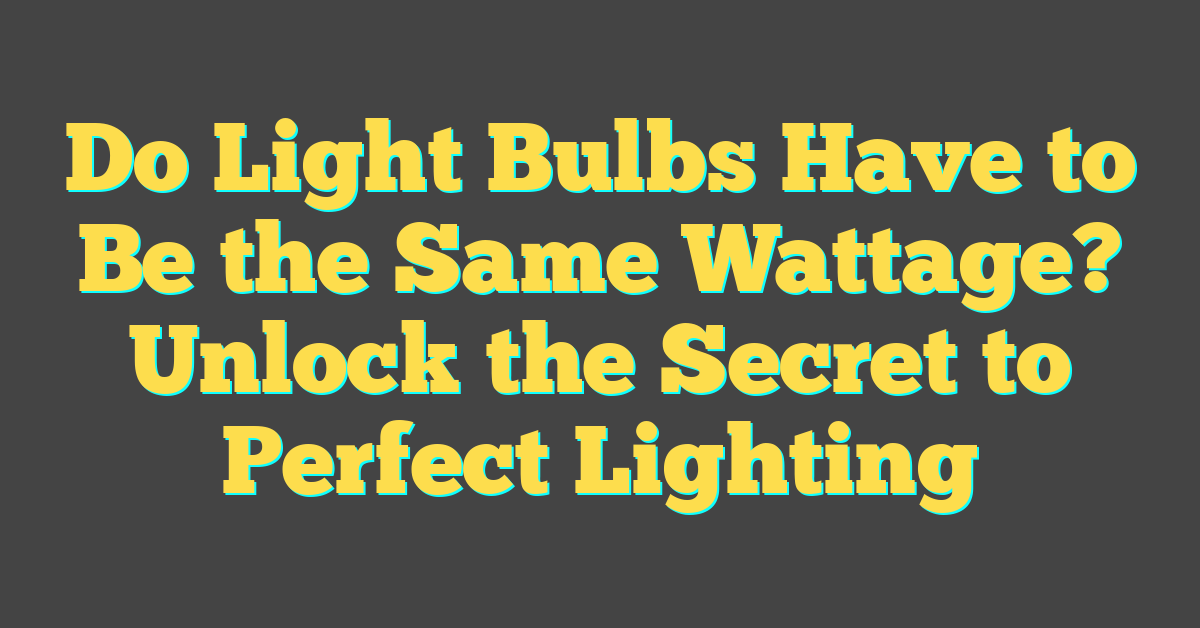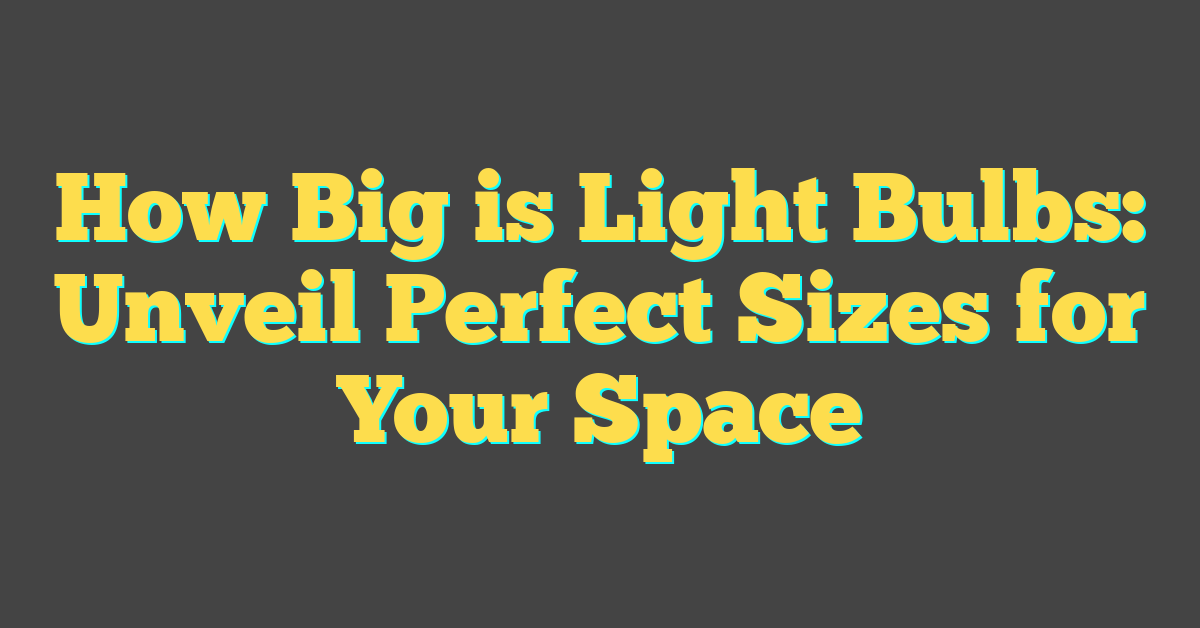Ever found yourself staring at the lighting aisle, wondering if all your light bulbs need to match in wattage? You’re not alone. Choosing the right bulb can feel like a puzzle, especially with the variety of options available.

Mixing and matching wattages in your home might seem like a minor detail, but it’s actually a bright idea to understand the basics. Let’s shed some light on whether your bulbs need to be twins in wattage or if they can be more like distant cousins.
What is wattage?
Think of wattage as the measure of the energy a light bulb consumes. It’s like your light bulb’s appetite, with higher wattage bulbs being the big eaters of your electrical system. When you’re rummaging through the lighting aisle, you might notice bulbs ranging from low-wattage LEDs to higher-wattage incandescent bulbs.
Wattage is crucial for several reasons:
- It dictates the bulb’s energy consumption.
- It’s related to the bulb’s brightness, although not as directly as you might think.
- It impacts the heat emitted by the bulb – higher wattage usually means more heat.
As a lighting aficionado, you’ll find that wattage also has an impact on eco-friendliness and electricity costs. Those sleek LED bulbs that you’ve been eyeing could have a wattage as low as 10 watts, while belting out the brilliance of an old 60-watt incandescent. This is where the term ‘wattage equivalent’ comes into play, illustrating that wattage isn’t the only factor in deciding a bulb’s luminosity.
Matching Wattages: Why Does It Matter?
In the DIY world of home lighting, you’ll often hear that mismatched wattages are a no-go. Here’s what you have to consider:
- Fixtures have maximum wattage ratings. Overloading them with a high-watt buld could be a fiery faux pas.
- Consistent wattages ensure uniform light levels, reducing odd shadows and uneven illumination.
However, as an experienced DIYer, you’ll understand that a lower-watt bulb can sometimes serve the purpose just fine, and there might be strategic reasons to mix things up. An intimate dinner party, for example, doesn’t need the runway-beaming brightness of your kitchen workspace.
Understanding wattage helps you tailor your home lighting to create the atmosphere you’re after, whether it’s bright and inviting or soft and serene. As you dive deeper into the quest for perfect lighting, remember to respect the limits of your fixtures and consider both the aesthetic and practicality of your lighting choices.
Why does wattage matter?

When you’re knee-deep in a home DIY lighting project, wattage is like your trusty toolbox—it’s fundamental. Wattage represents the power consumed by the bulb, directly influencing how much it’ll cost you on your electric bill. Higher wattage equals more energy consumed and, as a result, a higher electricity cost. But it’s not just about the bills.
Think of wattage as the secret ingredient to the perfect ambiance. A dimly lit room might call for lower wattage bulbs, setting a cozy and relaxed mood. Whereas, in your garage or workspace, higher wattage bulbs eliminate shadows and brighten the area, ensuring you don’t miss a beat—or a nail—on your next project.
Here’s where it gets interesting, though. The wattage you choose doesn’t just affect the brightness; it determines the heat emitted by the bulb. Ever touched a bulb after hours of use and recoiled at its heat? That’s the wattage at play. In fact, traditional incandescent bulbs convert only 10-20% of the energy they consume into light; the rest is heat. This isn’t a thumb rule for all light sources, though—LEDs are much cooler, converting a larger portion of energy into light and making them a safer, more eco-friendly option.
Balancing your lighting not only enhances your home’s functionality, but it also curtails how much heat you’re adding to the environment. If you live in a warmer climate, opting for lower-wattage bulbs could mean your air conditioning doesn’t have to work overtime combatting additional heat from your lighting.
Ambiance, cost, and safety—wattage is crucial to them all. Your lighting choices shape not just the look, but the feel and functionality of your home. Remember, the wattage you pick is a practical decision, but it’s also an artistic one. You’re crafting the light scape of your living space, shaping how every corner feels and functions. Whether it’s a warm, welcoming glow or a bright, vibrant shine, wattage is your paintbrush in the grand design of your home.
Can different wattages be used together?

« What Light Bulbs Can You Not Touch? Handle With Care to Prolong Life
How Many Light Bulbs Are There in the United States? Shocking Numbers Revealed »
Absolutely, you can mix and match light bulbs of different wattages in your home. It’s a common misconception that bulbs in the same room or fixture must be the same wattage. The reality is that varying wattages can work to your advantage, especially when creating layers of light to add depth and character to your space.
Think about your living room. You might crave a cozy atmosphere for movie nights and a brighter setting for reading. By combining low-wattage bulbs in floor lamps and higher-wattage bulbs overhead, you’ll have the flexibility to adjust the room’s ambiance to suit your activities.
When you’re blending wattages, it’s critical to keep the fixture’s maximum wattage in mind. This is the total wattage the fixture can safely handle without the risk of overheating. For example, if a ceiling fixture has a maximum of 60 watts per socket and holds three bulbs, you shouldn’t exceed 180 watts combined. Here’s a quick breakdown:
| Fixture Socket Maximum | Number of Sockets | Total Maximum Wattage |
|---|---|---|
| 60 watts | 3 | 180 watts |
Bear in mind, though, that using lower wattages than the maximum is often advantageous. With LEDs, you’ll achieve comparable brightness to higher-wattage incandescent bulbs while staying well under the threshold, thus increasing safety and energy efficiency.
In areas where tasks are performed, like the kitchen, variable wattages can cater to both general and task-focused lighting needs. Brightness is essential over prep areas, but you might opt for softer lighting over the dining area within the same room. This strategy not only conserves energy but also maintains practicality and invites a welcoming warmth.
On your next DIY home lighting project, don’t shy away from experimenting with different wattages. The right mix can enhance your home’s functionality and aesthetics, leading to a tailored lighting experience that complements your unique lifestyle. Remember; lighting isn’t just about visibility—it’s about creating a mood and enhancing your home environment.
Should all light bulbs have the same wattage?

When you’re sprucing up your living space, it’s tempting to streamline everything for uniformity, including your light bulbs. Sure, uniform wattage can offer a consistent look, but here’s the catch—it’s not always necessary or ideal. Your home is a tapestry of spaces, each with unique functions and vibes. You wouldn’t wear sunglasses in a dimly lit jazz cafe, right? So why adhere to only one wattage in all your rooms?
Layering different wattages in a single room not only caters to diverse activities, but also introduces versatility in lighting. Got a cozy reading nook? Slot in a higher wattage bulb there for clarity. Favor a softer ambiance when you’re kicking back with a movie? A lower wattage bulb can set that perfect, relaxed mood.
Kitchen Lighting: A Case Study
Let’s slice into the kitchen, your culinary canvas. Here’s where wattage variation shines. You’ll want brighter lights (higher wattage) where you’re slicing and dicing but perhaps subtler (lower wattage) bulbs where you sit to savor a coffee.
Task lighting over counters benefits from higher wattages, while ambient lighting can play with lower wattages giving a warm glow. Your kitchen is dynamic—your light should be too.
Remember the capacity of your fixtures. Exceeding the maximum wattage is a big no-no—it’s a safety hazard. Always check the label!
Bedroom Bliss with Adjustable Wattage
Consider your bedroom. It’s your sanctuary. You’ll want calm, soft lights (lower wattage) to wind down at night. But what about morning routines? Swapping to a higher wattage can kickstart your day with energy—a multi-bulb fixture allows this flexibility. Tried dimmer switches? They’re a game-changer, offering real-time adjustments without switching bulbs!
Embrace the unique needs of each corner in your home and don’t shy away from mixing wattages where it makes sense. It’s about creating the right mood and functionality. Dive into the world of lighting, experiment, and watch your space transform with every flick of the switch.
Factors to consider when using different wattages

When you’re keen on tailoring your living spaces with various light wattages, there are certain factors you should keep in mind to ensure everything works smoothly. Being a zealous home DIY enthusiast, you’ll appreciate the need for a blend of practicality and aesthetics in your lighting choices.
Room Function plays a vital role in how you choose your bulb wattages. For instance, your home office might demand brighter light (higher wattage) for productivity, whereas your bedroom might call for lower wattage bulbs that emit a softer glow conducive to relaxation.
Fixture Compatibility is next on your checklist. Always check the manufacturer’s specifications for maximum wattage to prevent potential overheating which could lead to hazards. Nothing puts a damper on a DIY project like a safety concern, so it’s better to be diligent.
Energy Efficiency is a balancing act. You may want to optimize the wattage for energy savings without sacrificing the quality of light. LED bulbs could be your best friend here, offering more light per watt compared to traditional bulbs. This means you can go for a lower wattage without compromising on brightness.
Consider the Ambiance you want to craft. Different wattages can cast a variety of tones across your rooms. The living room might have a high-wattage centerpiece surrounded by lower-wattage lamps to create a dynamic and versatile environment.
Lastly, let’s talk about the Size of the Space. Larger areas generally require bulbs with higher wattage to illuminate the space properly.
- Small room → Lower wattage
- Large room → Higher wattage
Keep these factors in mind, and you’ll find that mixing wattages can be less about rules and more about creative flexibility. You’ve got the know-how; now, it’s time to illuminate your home in a way that reflects your personal style and functionality needs.
Conclusion
So there you have it. You’re now equipped with the knowledge that mixing wattages can indeed work to your advantage. It’s all about understanding your space and what you want to achieve. Remember to always check the maximum wattage for safety and consider using dimmer switches for flexibility. Go ahead and play around with different wattages—after all, your home is your canvas. Light it up in a way that reflects your style and meets your needs. Happy lighting!
Frequently Asked Questions
What does wattage in light bulbs signify?
Wattage measures the bulb’s power consumption. Higher wattage bulbs consume more energy and usually produce more light, whereas lower wattage bulbs conserve energy and emit less light.
Can different wattages be used together in the same space?
Yes, using different wattages in the same room or fixture can help create a layered lighting effect that can enhance ambiance and functionality, catering to a range of activities.
Why is considering a fixture’s maximum wattage important?
Considering a fixture’s maximum wattage is crucial to prevent overheating and potential safety hazards. Always ensure that the light bulb’s wattage does not exceed the fixture’s recommended limit.
How can wattage variation benefit areas like the kitchen and bedroom?
In the kitchen, higher wattage bulbs provide better task lighting for cooking. In the bedroom, lower wattage bulbs help create a relaxing atmosphere conducive to rest and relaxation.
What factors should be considered when using different wattages?
When choosing different wattages, consider room function, fixture compatibility, energy efficiency, the desired ambiance, and the size of the space to ensure the lighting is both practical and aesthetically pleasing.
Are dimmer switches a good option for adjusting lighting?
Dimmer switches are an excellent option for making real-time adjustments to a light bulb’s brightness. They provide flexibility and can help save energy by reducing light output when full brightness isn’t needed.




